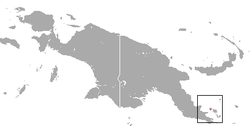Goodenough bush kangaroo
| Goodenough bush kangaroo | ||||||||||||
|---|---|---|---|---|---|---|---|---|---|---|---|---|
| Systematics | ||||||||||||
|
||||||||||||
| Scientific name | ||||||||||||
| Dorcopsis atrata | ||||||||||||
| Van Deusen , 1957 |
The goodenough bush kangaroo ( Dorcopsis atrata ), also known as the black bush kangaroo , is a rare species of the bush kangaroo genus . It is on the Goodenough Island off the coast of Papua New Guinea endemic .
features
The Goodenough bush kangaroo reaches a head-trunk length of 550 to 693 millimeters, a tail length of 255 to 423 millimeters and a weight of 3.9 to 7.5 kilograms. The rear foot length is 96.8 to 118 millimeters and the ear length is 2.8 to 3.5 centimeters. The coat of the goodenough bush kangaroo is blackish on the back and dark brown on the belly. The tail is hairless on the terminal half. The nose is large, broad and hairless. The ears are small and rounded. The hind feet are small while the front feet are well developed and sturdy. The claws are very strong. Many individuals have white soles on their forefeet and a white tip of the tail.
habitat
The Goodenough bush kangaroo inhabits oak and pseudo- chestnut mountain forests at medium altitudes between 900 and 1600 m. It probably also occurs in pseudo-beech forests at altitudes between 1600 and 1800 meters and undertakes hikes in mixed rainforests below 900 meters. However, there is no clear evidence of this.
Way of life
Little is known about the way of life of the Goodenough bush kangaroo. It is mostly nocturnal. However, there have been reports that it spends the day in dense forests. Observations on a group in human care in 1989 showed a crepuscular lifestyle. The diet consists of roots, leaves, grasses and fruits. During mating, the male bites the female's neck. The females give birth to a young. When the goodenough bush kangaroo is sitting or slowly hopping, only the tail end touches the ground.
Danger
In the past, the goodenough bush kangaroo was heavily hunted for its meat . During a visit to Goodenough Island in 1995, the Australian zoologist Tim Flannery found that the hunting pressure had decreased and that the species was mainly endangered by slash and burn . In 2008, the IUCN classified the Goodenough bush kangaroo in the critically endangered category.
Individual evidence
- ^ Tim Flannery: Mammals of New Guinea . Cornell University Press, Cornell 1995. ISBN 0-8014-3149-2
literature
- Hobart Merritt Van Deusen: A new species of wallaby (genus Dorcopsis) from Goodenough Island, Papua . In: American Museum Novitates number 1826. American Museum of Natural History. New York, NY, 1957.
- Menkhorst, P. & Knight, F. 2001. A Field Guide to the Mammals of Australia . South Melbourne: Oxford University Press. ISBN 0-19-550870-X
- Ronald M. Nowak: Walker's Mammals of the World . Johns Hopkins University Press, 1999 ISBN 0-8018-5789-9
- Jane Thornback, Martin Jenkins: The IUCN Mammal Red Data Book Part 1 . International Union for Conservation of Nature and Natural Resources. Species Survival Commission, 1982. ISBN 9782880326005
Web links
- Conservation International - Making New Friends To Save A Rare Wallaby
- Dorcopsis atrata in the endangered Red List species the IUCN 2008. Posted by: Leary, T. Wright, D., Hamilton, S., Singadan, R. Menzies, J., Bonaccorso, F., slipway, K., Seri, L., Allison, A. & James, R., 2008. Retrieved March 15, 2009.
- Illustration by Peter Schouten
